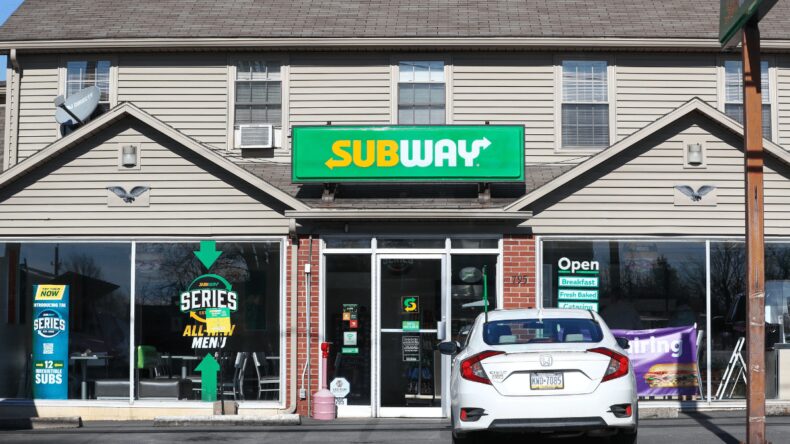Subway, the American fast-food chain, has come up with a $5 billion debt plan to secure a $10 billion-plus sale, according to a report by Reuters. The plan is part of the company’s efforts to restructure its business and reduce its debt load as it seeks to attract buyers. The move comes amid a challenging environment for the restaurant industry, which has been hit hard by the COVID-19 pandemic.

Subway’s debt plan includes a $2.5 billion loan from banks led by JPMorgan Chase & Co. and Goldman Sachs Group Inc., and a $2.5 billion bond offering, according to anonymous sources cited in the Reuters report. The bond offering is expected to be split into two parts: a $1.5 billion tranche that matures in seven years and a $1 billion tranche that matures in 10 years. The company plans to use the proceeds to pay off existing debt and to fund other corporate purposes.
The move is seen as an attempt to make itself more attractive to potential buyers. The company has been seeking a buyer for several months, with reports suggesting that it has been in talks with private equity firms and other potential buyers. Subway’s founder, Fred DeLuca, died in 2015, and the company has struggled in recent years to keep up with changing consumer tastes and the rise of competitors such as Chipotle and Panera Bread.
Subway’s debt load has also been a concern for potential buyers. The company had around $8 billion in debt as of 2020, according to Moody’s Investors Service. Moody’s has also given Subway a credit rating of Caa1, which is considered speculative and indicates a high risk of default.
The COVID-19 pandemic has added to Subway’s challenges. The company has been hit hard by the pandemic, with many of its franchisees struggling to stay afloat amid lockdowns and reduced foot traffic. Subway has also been criticized for its handling of the pandemic, with some franchisees accusing the company of not doing enough to support them.
Despite these challenges, Subway remains a major player in the fast-food industry. The company has more than 23,000 restaurants in the United States and over 100 countries worldwide. Subway has also been making efforts to adapt to changing consumer tastes, such as by introducing new menu items and offering delivery and mobile ordering.
The sale of Subway is likely to be closely watched by industry observers. The restaurant industry has been undergoing significant changes in recent years, with consumers increasingly demanding healthier and more sustainable options. The COVID-19 pandemic has also accelerated trends such as delivery and online ordering, which are likely to have a lasting impact on the industry.
Subway’s debt plan includes a $2.5 billion loan from banks led by JPMorgan Chase & Co. and Goldman Sachs Group Inc., and a $2.5 billion bond offering, according to anonymous sources cited in the Reuters report. The bond offering is expected to be split into two parts: a $1.5 billion tranche that matures in seven years and a $1 billion tranche that matures in 10 years. The company plans to use the proceeds to pay off existing debt and to fund other corporate purposes.
The move is seen as an attempt by Subway to make itself more attractive to potential buyers. The company has been seeking a buyer for several months, with reports suggesting that it has been in talks with private equity firms and other potential buyers. Subway’s founder, Fred DeLuca, died in 2015, and the company has struggled in recent years to keep up with changing consumer tastes and the rise of competitors such as Chipotle and Panera Bread.
Subway’s debt load has also been a concern for potential buyers. The company had around $8 billion in debt as of 2020, according to Moody’s Investors Service. Moody’s has also given Subway a credit rating of Caa1, which is considered speculative and indicates a high risk of default.
The COVID-19 pandemic has added to Subway’s challenges. The company has been hit hard by the pandemic, with many of its franchisees struggling to stay afloat amid lockdowns and reduced foot traffic. Subway has also been criticized for its handling of the pandemic, with some franchisees accusing the company of not doing enough to support them.
Despite these challenges, Subway remains a major player in the fast-food industry. The company has more than 23,000 restaurants in the United States and over 100 countries worldwide. Subway has also been making efforts to adapt to changing consumer tastes, such as by introducing new menu items and offering delivery and mobile ordering.
The sale of Subway is likely to be closely watched by industry observers. The restaurant industry has been undergoing significant changes in recent years, with consumers increasingly demanding healthier and more sustainable options. The COVID-19 pandemic has also accelerated trends such as delivery and online ordering, which are likely to have a lasting impact on the industry.












